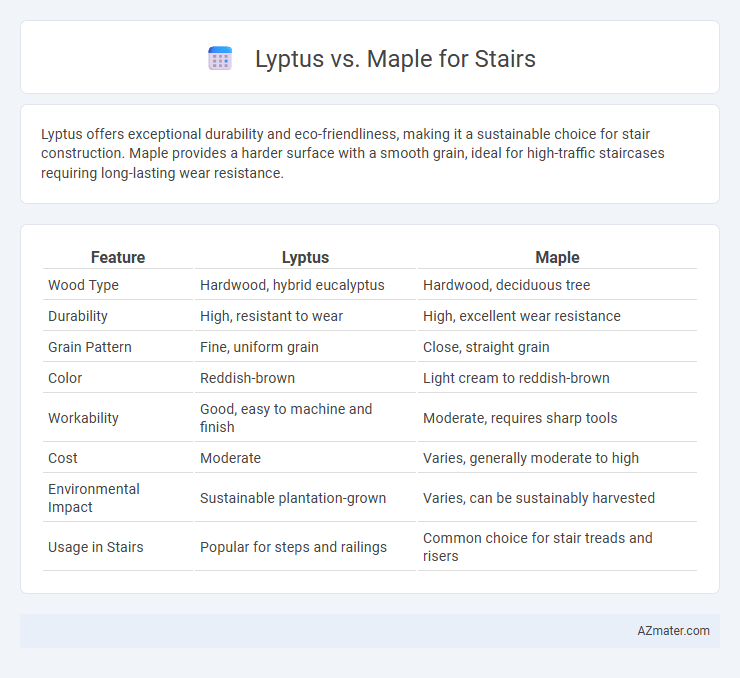Lyptus offers exceptional durability and eco-friendliness, making it a sustainable choice for stair construction. Maple provides a harder surface with a smooth grain, ideal for high-traffic staircases requiring long-lasting wear resistance.
Table of Comparison
| Feature | Lyptus | Maple |
|---|---|---|
| Wood Type | Hardwood, hybrid eucalyptus | Hardwood, deciduous tree |
| Durability | High, resistant to wear | High, excellent wear resistance |
| Grain Pattern | Fine, uniform grain | Close, straight grain |
| Color | Reddish-brown | Light cream to reddish-brown |
| Workability | Good, easy to machine and finish | Moderate, requires sharp tools |
| Cost | Moderate | Varies, generally moderate to high |
| Environmental Impact | Sustainable plantation-grown | Varies, can be sustainably harvested |
| Usage in Stairs | Popular for steps and railings | Common choice for stair treads and risers |
Introduction to Lyptus and Maple for Stairs
Lyptus is a fast-growing hardwood derived from hybrid eucalyptus trees, known for its consistent grain and durability, making it an eco-friendly alternative to traditional hardwoods for stairs. Maple, a dense and strong hardwood commonly used in stair construction, offers a smooth surface and excellent wear resistance, ideal for high-traffic areas. Both woods provide reliable structural integrity, but Lyptus stands out for its sustainable sourcing, while maple is prized for its classic appearance and hardness.
Appearance and Grain Patterns
Lyptus stairs exhibit a consistent, smooth grain with a reddish-brown hue that darkens over time, offering a modern and uniform appearance. Maple features a lighter cream to pale reddish-brown color with subtle, wavy grain patterns that provide a classic, elegant look. The uniformity of Lyptus suits contemporary designs, while maple's natural variations work well in traditional and transitional staircases.
Hardness and Durability Comparison
Lyptus hardwood, derived from fast-growing eucalyptus trees, offers a Janka hardness rating of about 1,450, which makes it moderately hard and suitable for stairs that experience regular foot traffic. Maple wood, particularly hard maple (sugar maple), boasts a higher Janka hardness of approximately 1,450 to 1,620, providing superior durability and resistance to dents and scratches compared to Lyptus. When choosing between the two for stairs, maple generally delivers enhanced long-term wear and resilience, making it a preferred choice for high-traffic areas.
Sustainability and Environmental Impact
Lyptus wood is a fast-growing, sustainably harvested hybrid eucalyptus species that offers a lower environmental impact compared to traditional hardwoods like maple. Maple, while durable and locally available in many regions, often requires longer growth periods and more intensive forest management practices that can lead to habitat disruption. Choosing Lyptus for stairs supports reduced deforestation and promotes responsible forestry, making it a more eco-friendly option in terms of carbon sequestration and renewability.
Cost and Availability
Lyptus offers a cost-effective alternative to maple for stair construction due to its faster growth rate, resulting in lower prices and sustainable sourcing. Maple, while often more expensive, provides a traditional, high-quality hardwood that is widely available in North American markets. Availability of lyptus can be regionally limited compared to the more consistently accessible maple, affecting overall project timelines and budget considerations.
Workability and Installation
Lyptus offers excellent workability due to its fine, even grain and consistent hardness, which allows for smooth sanding, cutting, and finishing, making it ideal for precise stair components. Maple, especially hard maple, is dense and durable but can be more challenging to machine, requiring sharper tools and increased effort during installation. Both woods provide reliable performance for stairs, but Lyptus generally facilitates easier handling and faster installation due to its uniform texture and stability.
Maintenance and Longevity
Lyptus offers superior resistance to moisture and stains, resulting in easier maintenance compared to maple, which requires regular sealing and can be prone to surface scratches. The dense grain structure of Lyptus enhances durability and longevity, making it less susceptible to wear and tear over time than maple. While maple is a classic choice with a traditional aesthetic, Lyptus combines both strength and low upkeep, ideal for high-traffic stair areas.
Finishing and Stain Options
Lyptus offers a uniform grain that accepts finishes and stains evenly, providing a smooth and consistent appearance ideal for modern staircases. Maple, with its tighter, finer grain, allows for a wide variety of stain options that enhance its natural light color, offering versatility for both traditional and contemporary stair designs. Both woods respond well to sealing and varnishing, but Lyptus tends to maintain color stability better under UV exposure, making it suitable for stairs in well-lit areas.
Best Applications for Each Wood Type
Lyptus wood, known for its durability and resistance to wear, performs best in high-traffic staircases where strength is essential, offering a harder surface that withstands foot traffic and impacts. Maple, prized for its fine grain and smooth finish, excels in decorative staircases or areas requiring a refined aesthetic, as it sands well and easily accepts stains and paints. Choosing Lyptus suits modern, robust stair designs, while Maple is ideal for traditional or intricate staircases demanding elegance and detailed finishes.
Choosing Between Lyptus and Maple for Your Stairs
Lyptus wood offers a sustainable alternative with exceptional hardness and a warm, reddish hue, ideal for staircases requiring durability and unique aesthetics. Maple provides a classic, light-toned appearance with fine grain, known for its strength and resistance to wear, making it a popular choice for traditional stair designs. When choosing between Lyptus and Maple for stairs, consider the environmental impact, desired color palette, and maintenance requirements to ensure a balance between sustainability and long-lasting beauty.

Infographic: Lyptus vs Maple for Stair
 azmater.com
azmater.com